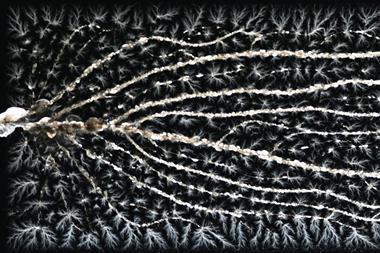Researchers in Belgium have gathered fresh evidence that a relaxation mechanism first observed in liquid polymers is a universal feature of liquid and glassy materials.1
Glasses are non-equilibrium disordered materials. Their properties evolve stochastically with time, while searching for a stable equilibrium state. Equilibration theories consider the microscopic evolution of molecules toward equilibrium and formulate macroscopic laws for their average behaviour. Segmental relaxation (a-relaxation) is the main equilibration mechanism in polymers and is characterised by activation energies and relaxation times that vary with a system’s temperature.
However, in 2022, a team around Simone Napolitano from the Free University of Brussels in Belgium identified a new and unprecedented relaxation mechanism with a constant activation energy.2 They observed this so-called slow Arrhenius process in liquid polymers and showed it was sample and scale invariant.
Now, Napolitano and Federico Caporaletti have observed the slow Arrhenius process in molecular glasses made from three small organic molecules: tris(4-carbazoyl9-ylphenyl)amine, bis(3-methylphenyl)-N,N’-diphenylbenzidine and telmisartan. The duo prepared thin film samples of the molecules via a bottom-up process and altered the solvent concentration to vary the thickness. They then applied broadband dielectric spectroscopy techniques to the thin glass films, which tracked the orientation of the molecules’ dipole moments to visualise the relaxation dynamics in real-time. Their preparation technique reduced the influence of parasitic dielectric signals in the range of frequencies where the slow Arrhenius process occurs.
Calculations of the corresponding activation energies in the small molecule samples matched the regression line obtained for the slow Arrhenius process in polymers. Napolitano and Caporaletti were astonished by the agreement between the regression line and their experimental results, which demonstrated that the slow Arrhenius process also occurred in small molecules.
Fernando Bresme, a professor of chemical physics at Imperial College London in the UK, says the newly established relaxation process requires additional validation, for example when interpreting slow relaxation processes in liquids. ‘Theory and simulation in combination with experiments, might help to build a microscopic picture of the molecular rearrangement determining the slow Arrhenius process and link the slow Arrhenius process mechanism to specific molecular characteristics of glassformers,’ he adds.
Caporaletti, meanwhile, says the slow Arrhenius process will revolutionise equilibration models for liquid polymers. ‘By taking into account a-relaxation and slow Arrhenius processes, can we develop a model to predict how an amorphous material will evolve in time depending on the preparation conditions? That would be the fundamental goal from a fundamental and practical point of view.’
Predicting the impact of such a discovery on applied material development is hard at this point. However, Caporaletti says understanding relaxation mechanisms is key to ‘tailoring materials’ properties and predicting the shelf-life of polymer-based products’.
References
1 F Caporaletti and S Napolitano,Phys. Chem. Chem. Phys., 2024, 26, 745 (DOI: 10.1039/d3cp05044k)
2 Z Song et al,Sci. Adv., 2022, DOI: 10.1126/sciadv.abm7154












No comments yet